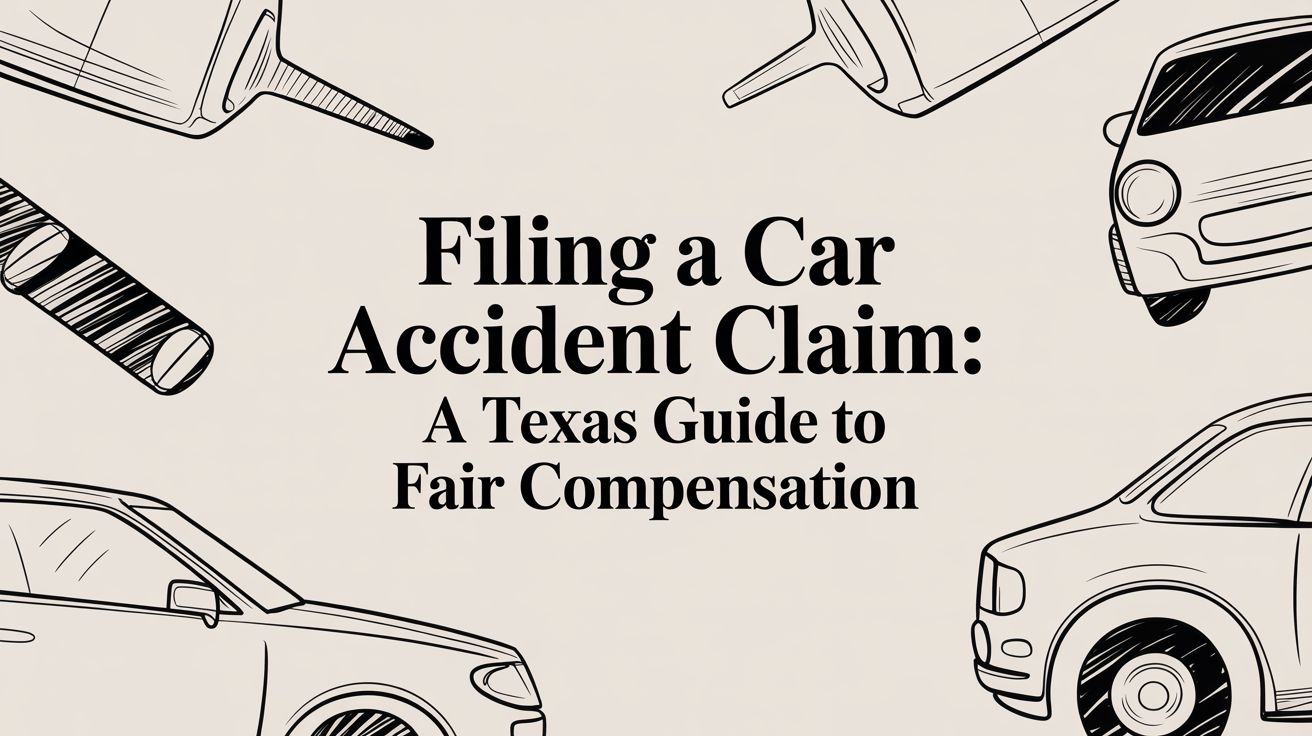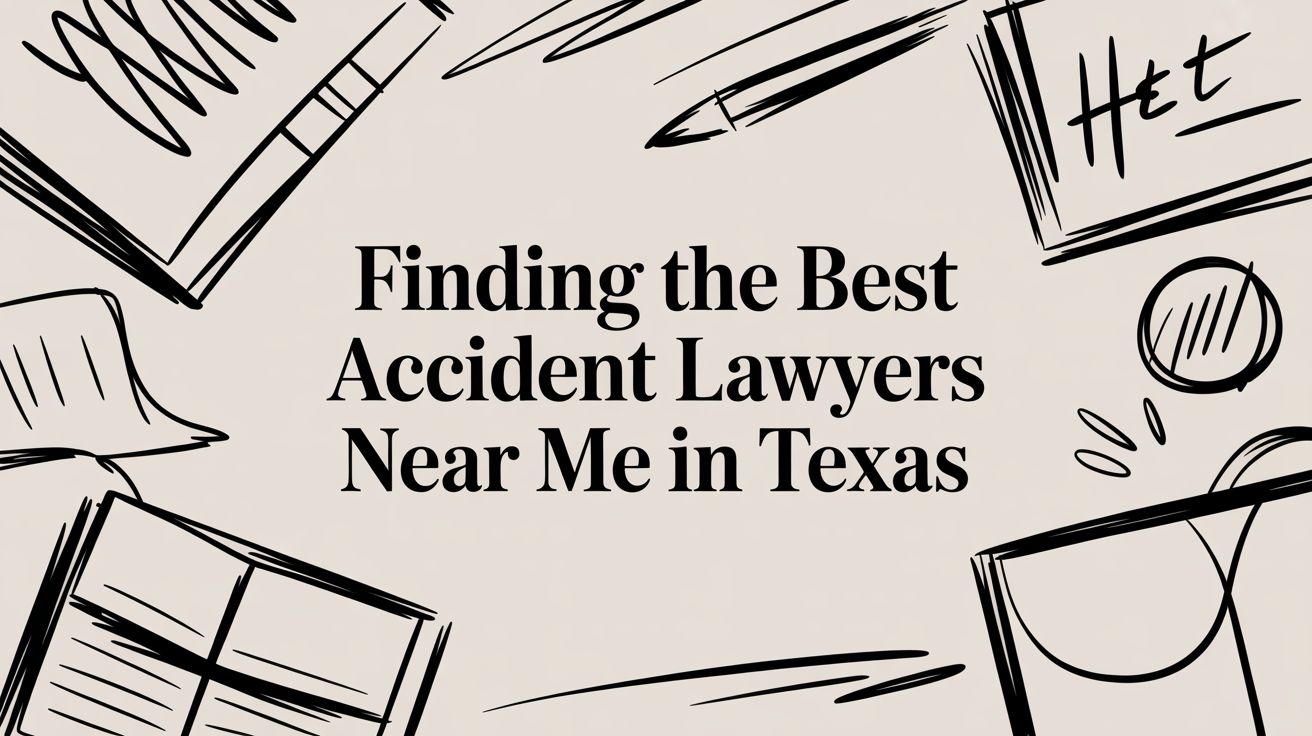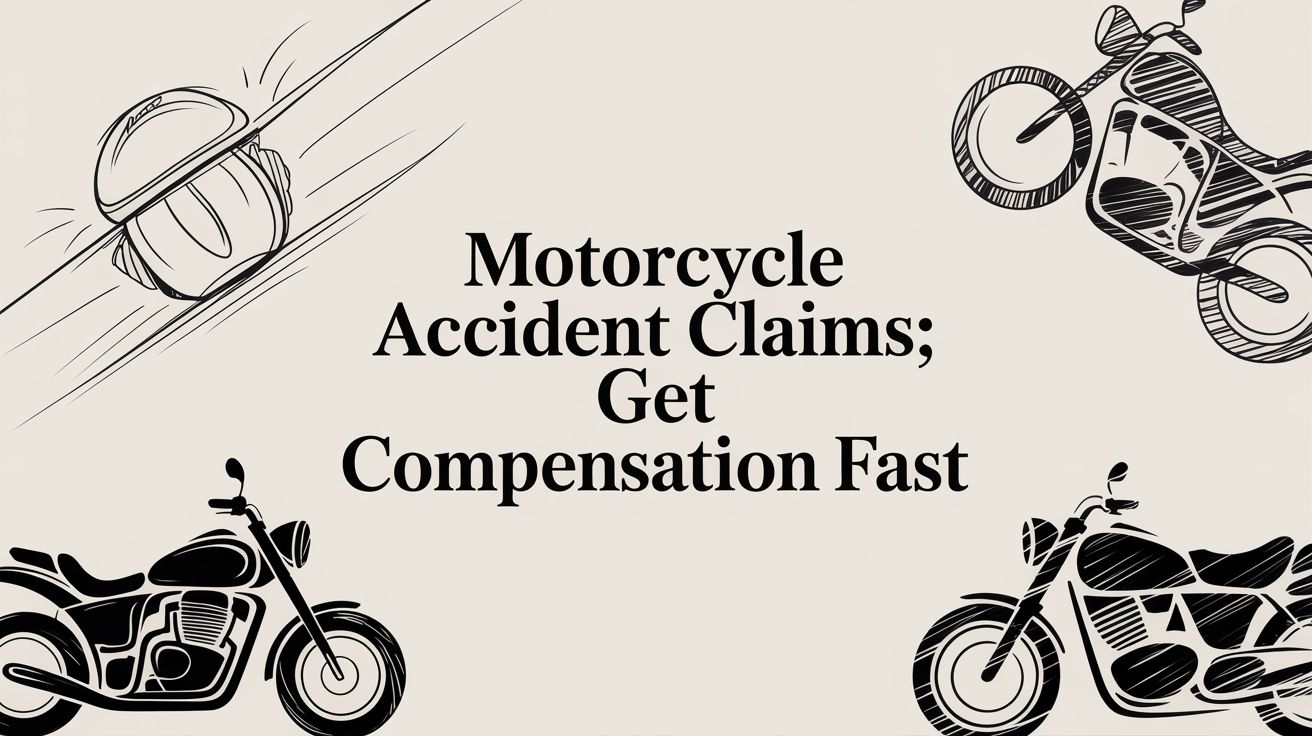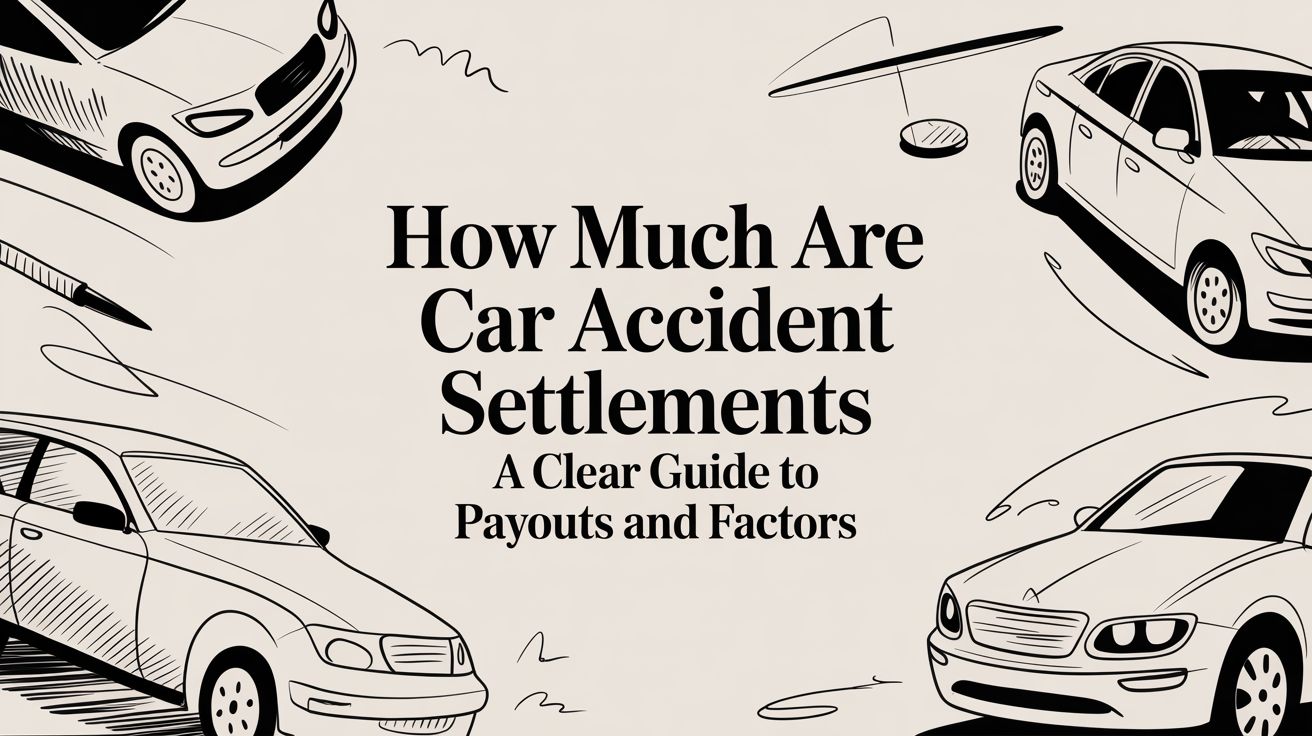A serious accident can change your life in seconds—but you don’t have to face it alone. Many people think negotiating a personal injury settlement starts with a phone call to the insurance adjuster. The truth is, it begins the moment the accident happens, with the immediate actions you take to protect your rights and preserve evidence.
Building a strong foundation from day one is everything. It's the key to securing the fair compensation you need to focus on what truly matters: your recovery.
Protecting Your Claim From the Very Beginning
The moments after an accident are chaotic. Whether you're in a multi-car pileup on a Houston freeway or you've slipped and fallen on someone else's property, your first instinct is your health and safety—and that's exactly where it should be.
But you need to know this: the insurance company starts building its case against you from the second the accident is reported. Their job is to find any reason possible to minimize your claim or deny it outright. To counter this, you have to be just as diligent in building your own case. This isn't about being aggressive; it's about being prepared.
Seek Immediate Medical Attention
Your health is the absolute top priority. We can't stress this enough. Even if you think you just have minor bumps and bruises, get checked out by a doctor right away. Adrenaline is a powerful chemical that can easily mask serious injuries like internal bleeding or a concussion. Symptoms for other common injuries, like whiplash, might not even show up for hours or days.
Getting immediate medical care does two critical things for you:
- It protects your health. A doctor can spot hidden injuries and get you on a treatment plan that prevents long-term complications.
- It creates an official record. Your medical charts become the single most important piece of evidence linking your injuries directly to the accident. Any delay gives the insurance adjuster a perfect excuse to argue that your injuries happened somewhere else or aren't as bad as you claim.
This visual guide breaks down the essential first steps to take after an injury to safeguard your claim.
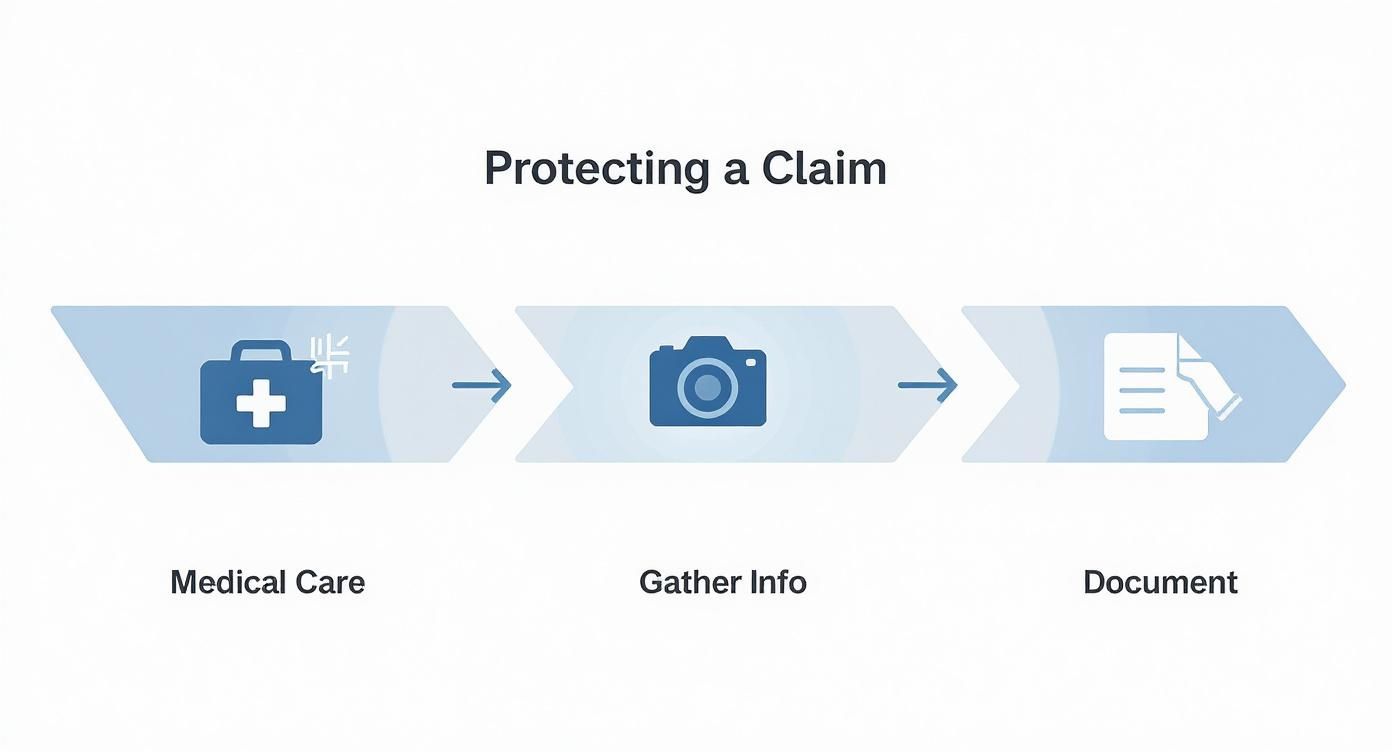
As you can see, protecting your right to compensation starts with prioritizing your health, followed by carefully collecting evidence and documenting everything.
Gather and Preserve Crucial Evidence
If you are physically able to do so, start gathering information right there at the scene. Evidence has a way of disappearing fast, so documenting everything is your best move. Use your smartphone—it's your most powerful tool in these first few minutes. Take photos and videos of everything from every possible angle.
Be sure to capture images of:
- All vehicle damage
- Skid marks on the pavement
- The final resting positions of the cars
- Any relevant traffic lights or street signs
- Your visible injuries
Get the contact and insurance information from everyone involved. This is non-negotiable. Just as important, get the names and phone numbers of any witnesses. Their unbiased story can be invaluable, especially when the other driver decides to change their version of events later on. For a more detailed guide, you can learn more about how to file a personal injury claim in Texas and the specific steps required.
Start a Detailed Log of Everything
Your memory of the pain and the day-to-day struggles will fade over time, but a written record won't. From day one, start a journal or even just a simple note on your phone to document every single detail related to your accident and recovery. This log will become one of your most powerful tools when it's time to negotiate.
Keep a daily record of your pain levels, the challenges you face with simple tasks, and how the injuries are affecting your family and your mental health. This narrative is what brings the true, human cost of the accident to light for an adjuster.
Your log should include dates and notes for every doctor's appointment, prescription you fill, and every conversation you have with medical staff or insurance reps. Track every single expense, from your co-pays to the gas mileage for your physical therapy trips. Make sure you also log every day you miss from work. This meticulous record-keeping is what provides the undeniable proof you'll need to build a strong, fact-based demand for the compensation you deserve.
Calculating the True Value of Your Injury Claim

Before you even think about talking numbers with an insurance adjuster, you need to know exactly what your claim is worth. This isn't just a suggestion—it's the single most important step in the entire process.
One of the biggest mistakes injured Texans make is accepting the first offer they get. You have to understand that these initial offers are almost always lowballs. Adjusters are banking on the hope that you're desperate and don't grasp the true, long-term costs of your injuries.
To push back effectively, you need your own number—a figure backed by solid proof. This number is your anchor in the negotiation. It gives you the confidence to say "no" to a bad deal and clearly justify why you deserve more. Getting to that number means a deep dive into every single loss you've suffered, both on paper and in your personal life.
Tallying Your Economic Damages
The most straightforward part is adding up all your tangible, out-of-pocket costs. These are called economic damages, and they are the concrete foundation of your settlement demand. Every single dollar you’ve had to spend or have lost because of someone else's negligence needs to be on this list.
You must be meticulous. Track everything.
- All Medical Bills: This includes the ambulance ride, hospital stay, surgeries, physical therapy, prescriptions, and any follow-up appointments with specialists.
- Future Medical Needs: This is a crucial and often overlooked element. If your doctor says you'll need another surgery down the road or long-term care, the estimated cost of that future treatment absolutely belongs in your claim.
- Lost Wages: Count every single hour of work you missed. This isn’t just your base pay; it includes any lost overtime, bonuses, or commissions you would have earned.
- Loss of Earning Capacity: If your injuries are serious enough to keep you from returning to your old job, or if they limit what you can do for a living forever, this is a massive damage component that has to be calculated.
- Property Damage: This covers the obvious, like the cost to repair or replace your car, but also includes any other personal items destroyed in the accident, like a laptop or phone.
Valuing Your Non-Economic Damages
While adding up receipts is straightforward, the deepest impact of a serious accident is rarely financial. It’s personal. Here in Texas, the law recognizes this, and you have the right to demand compensation for these intangible losses, which we call non-economic damages. They’re tougher to put a price tag on, but they are just as real and just as important.
Think about it this way: After a Houston freeway crash, a construction worker who injures his back doesn't just lose out on a paycheck. He loses the ability to pick up his kids, to go fishing on the weekend, and to live a single day without pain. That "loss of enjoyment of life" is a very real, compensable damage.
Non-economic damages are meant to acknowledge the human cost of an accident. They are compensation for the pain, suffering, and emotional turmoil that have turned your life upside down.
Proving these damages takes a different kind of evidence. A daily pain journal where you document your struggles is powerful. So are written statements from your family and friends describing how the injury has changed you. If you've sought counseling for anxiety or PTSD, that therapist's testimony can be crucial in showing the true scope of your suffering.
Here’s a quick breakdown of the types of damages you can pursue in a Texas personal injury claim.
Types of Damages in a Texas Personal Injury Claim
| Type of Damage | What It Covers | Example |
|---|---|---|
| Economic | Tangible financial losses with a clear dollar value. | Medical bills, lost wages, vehicle repair costs. |
| Non-Economic | Intangible losses related to the human cost of the injury. | Pain and suffering, emotional distress, loss of enjoyment of life. |
| Future | Projected costs for both economic and non-economic damages. | Future medical treatments, anticipated lost earning capacity. |
| Punitive (Exemplary) | Awarded to punish the defendant for gross negligence. | A drunk driver with multiple prior convictions causes a fatal crash. |
Understanding these categories is the first step in building a comprehensive demand that reflects the full impact of the accident on your life.
Understanding Average Settlements and the Value of Representation
Every case is different, but it helps to have a frame of reference. National data shows that the value of a claim can swing dramatically based on the facts. For instance, the average settlement for a car accident in the U.S. is around $37,248. But for a complex medical malpractice case, that average jumps to $423,607.
Here’s the most critical statistic you need to know: studies have consistently shown that people who hire a personal injury lawyer receive settlements that are, on average, 340% higher than what they get when they go it alone. That number alone speaks volumes about the value of having a professional advocate in your corner. If you're curious, you can explore more data about settlement outcomes to see these trends for yourself.
How to Draft a Powerful Settlement Demand Letter
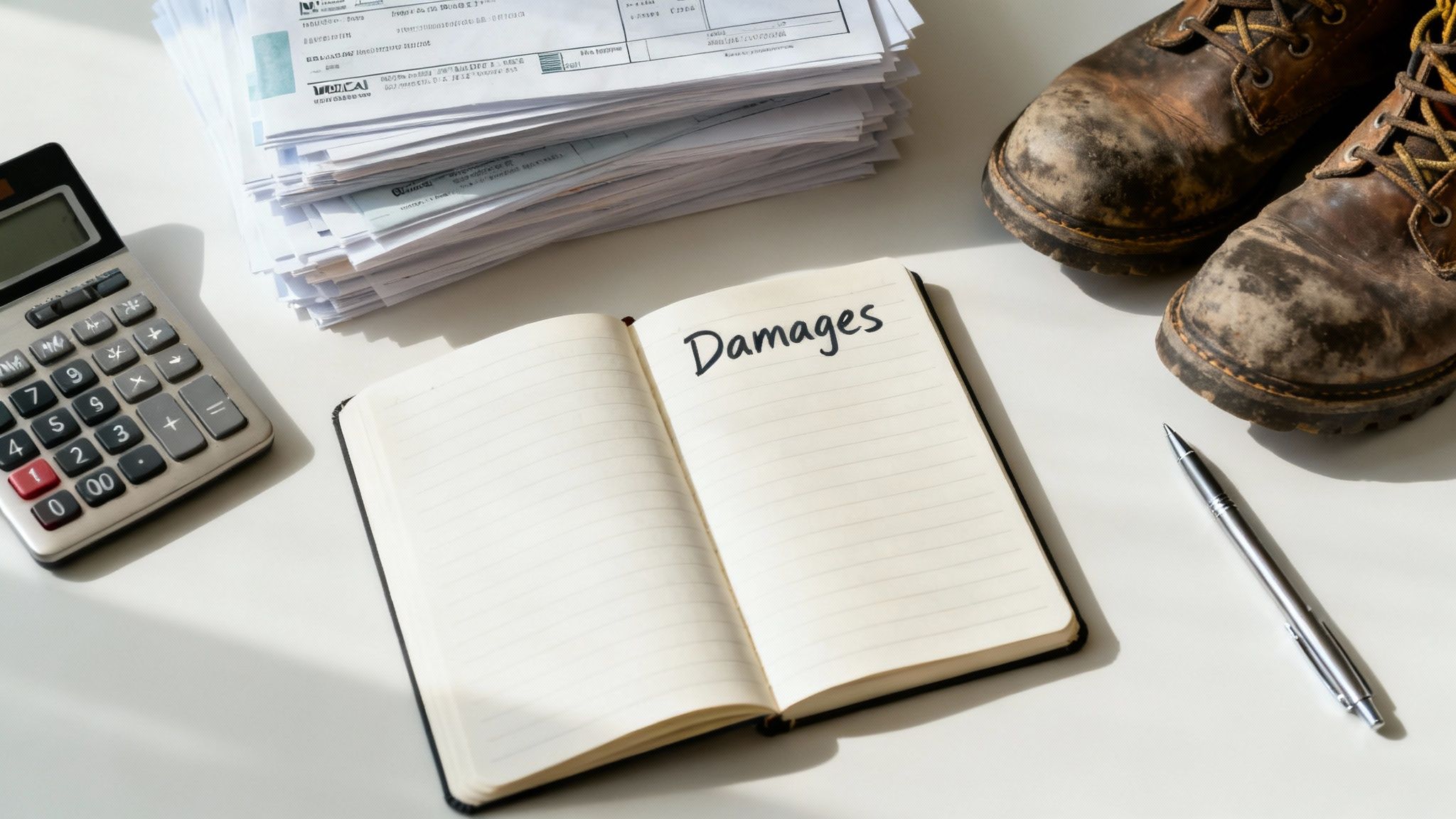
You’ve done the hard work of calculating your damages. Now it’s time to make your first official move in the negotiation process. This comes in the form of a settlement demand letter.
Think of this document as your opening argument. It’s your first real chance to tell your side of the story, present the cold, hard facts, and frame your case in a way that forces the insurance adjuster to sit up and pay attention.
A solid demand letter does more than just state a number. It establishes your credibility right away, showing the insurance company that you're organized, you’ve done your homework, and you’re not intimidated. This isn't just a letter; it’s a strategic play designed to anchor the entire negotiation in your favor from the get-go.
Key Components of a Strong Demand Letter
Your letter needs to be clear, professional, and convincing. It must follow a logical flow that makes it easy for the adjuster to follow your reasoning and understand your claim's value. A messy, incomplete letter signals weakness and practically invites a lowball offer.
A powerful letter will always have these core sections:
- A Factual Summary of the Accident: Lay out the basics: date, time, and location. Then, describe precisely how the collision happened, leaving no doubt as to why their insured client was at fault.
- A Clear Statement of Liability: This is where you draw a direct line from the other party’s negligence to the crash. For example, you might state that the other driver ignored a red light, violating a specific Texas traffic law and directly causing your injuries.
- A Detailed Description of Your Injuries: List every single injury you sustained. Don't leave anything out, from major fractures to what might seem like "minor" whiplash. Explain the medical care you've received and what your doctors are telling you about your long-term recovery.
- A Breakdown of Your Damages: This is the heart of your letter. Provide an itemized list of all your economic losses (medical bills, lost income) and then explain the foundation for your non-economic damages (pain and suffering). This is where you attach all your proof.
Weaving Your Story into the Facts
Facts and evidence are the backbone of your letter, but you also need to tell the human story of how this injury has derailed your life. Adjusters look at claims all day, every day. You have to make yours memorable.
This is where that personal journal you kept becomes priceless.
Instead of just writing "I suffered a broken leg," paint a picture of what that really meant. Talk about the nights you laid awake in pain, the frustration of being unable to do simple chores, or the deep sadness you felt missing your kid’s championship game. This personal narrative gives your pain and suffering claim real weight and makes the numbers feel tangible.
A demand letter should be a compelling blend of hard evidence and personal narrative. It shows the adjuster not just what the accident cost you in dollars, but what it cost you in quality of life.
Tone, Attachments, and Setting Your Demand
It is absolutely critical to maintain a firm but professional tone. Avoid angry or overly emotional language, which can damage your credibility. Let the facts do the talking and present your case with confidence. Remember, you are initiating a business negotiation.
Finally, you must include a specific dollar amount—the total you are willing to accept to resolve your claim. This number should be ambitious but completely justifiable, rooted in the detailed damage calculations you've already done. This is your opening bid.
Make sure you attach copies (never the originals) of all your supporting documents:
- The official police report from the accident
- All medical bills and records related to your treatment
- Photos showing the accident scene, vehicle damage, and your injuries
- A letter from your employer verifying your lost wages
Sending a comprehensive, well-organized demand package tells the insurance company you mean business. It communicates that you have built a powerful case and are fully prepared to fight for the compensation you deserve. This one document can set the entire tone for your settlement negotiation.
Navigating Common Insurance Adjuster Tactics
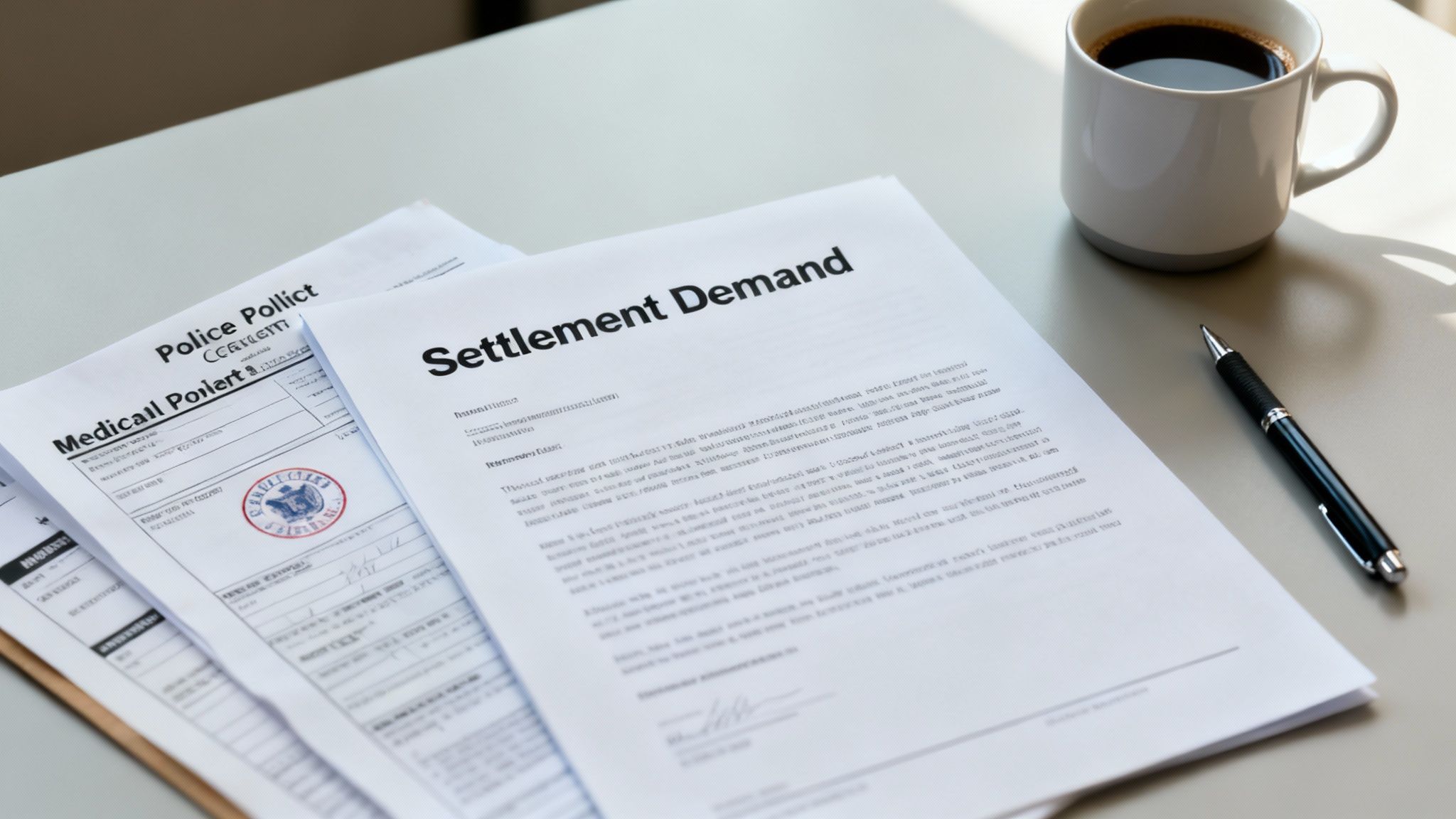
Once your demand letter lands on the adjuster’s desk, the real negotiation begins. They'll review your case and come back with a response, but you need to remember who you're dealing with. Their one and only job is to protect the insurance company’s bottom line, which means paying you as little as humanly possible.
These adjusters are trained negotiators. They have a playbook of tactics designed to wear you down and get you to accept a fraction of what your claim is actually worth.
Knowing their strategies ahead of time is your best defense. It helps you anticipate their moves, keep a cool head, and counter their arguments with the solid evidence you’ve already put together. This part of the process demands patience and a firm backbone.
The Unreasonably Low First Offer
You can be almost certain: the first settlement offer you get will be insultingly low. This isn’t a mistake; it’s a calculated move. Adjusters throw out these lowball offers for a few reasons:
- They're testing you. They want to see if you’re desperate enough to grab a quick, cheap payout just to be done with it.
- They're anchoring your expectations. A ridiculously low initial number can make their next offer—which is still too low—seem reasonable by comparison. It's a classic negotiation trick.
- They're weeding people out. Adjusters know that people without a lawyer are far more likely to be intimidated and accept a terrible offer.
Don’t get angry or discouraged. Simply reject the offer—politely but firmly—and ask them to provide a detailed, written justification for their valuation. This forces them to put their reasoning on paper, giving you a chance to dismantle their arguments with your own documentation.
Questioning Your Injuries and Medical Treatment
Another go-to tactic is to downplay how badly you were hurt. The adjuster might hint that you're exaggerating your pain or that some of your medical treatments were "unnecessary."
For instance, if you waited a couple of days after a Houston car accident to see a doctor for your back pain, you can bet the adjuster will pounce on that. They’ll argue your injury must not be that serious, or worse, that something else must have caused it. This is exactly why getting checked out immediately is so critical.
Your medical records are your shield here. Your doctor's notes, MRI reports, and prescribed treatment plan are your strongest proof. Keep meticulous records of every appointment and follow your doctor’s orders perfectly. Any gap or deviation is an opening for the adjuster to attack your claim.
Key Takeaway: An insurance adjuster's job is to create doubt. Your job is to erase that doubt with a mountain of credible, consistent evidence. Let your medical records, police report, and personal logs tell the undeniable story.
Shifting the Blame with Comparative Responsibility
Here in Texas, the law of comparative responsibility (sometimes called comparative negligence) is a huge factor in settlement talks. Under this rule, if you’re found to be partially at fault for the accident, your settlement gets reduced by your percentage of fault. And if you're found to be 51% or more at fault, you get nothing. Zero.
Adjusters know this rule by heart and use it like a weapon. They’ll dig for any tiny detail in the police report or a vague comment you made and try to blow it up into proof that you share the blame. For example, a lawyer for a trucking company might claim you were going a few miles over the speed limit to try and shave thousands off their payout after a crash.
This is where having a skilled truck crash lawyer Houston can make all the difference. An experienced Texas personal injury lawyer can bring in accident reconstruction experts and use witness statements to shut down these baseless claims and prove the other driver was overwhelmingly at fault. Patience is your single greatest asset in this fight. Rushing to a settlement almost always benefits the insurance company. By staying calm, sticking to the facts, and using your evidence to dismantle their tactics, you stay in control and dramatically increase your chances of getting the fair compensation you deserve.
How Long Do You Have to File a Claim in Texas?
In Texas, you generally have a two-year deadline, known as the statute of limitations, to file a personal injury lawsuit. This clock usually starts ticking on the date of the accident. If you miss this deadline, you will likely lose your right to seek compensation forever. While there are some rare exceptions, it's a critical deadline you cannot afford to ignore. Insurance companies know this and will often drag their feet, hoping you'll run out of time.
Why Most Injury Cases Settle Out of Court
If you're picturing a dramatic courtroom battle like something out of a movie, take a deep breath. That's rarely how these cases resolve. The simple truth is that the vast majority of personal injury cases in Texas are resolved through a negotiated settlement, long before a judge or jury ever gets involved.
Understanding this from the very beginning can lift a huge weight off your shoulders. It lets you focus your energy where it really matters: building a strong case for the negotiation table. This is where you'll secure the compensation needed to put your life back together, whether you're recovering from a catastrophic injury or fighting for justice after a wrongful death.
The Power of a Negotiated Settlement
For someone trying to heal from a serious injury, a settlement offers two things a trial never can: certainty and control.
When you agree to a settlement, you know the exact dollar amount you will receive and have a clear idea of when that money will arrive. That kind of predictability is priceless when you’re facing a mountain of medical bills and can't go back to work.
A jury trial, on the other hand, is a gamble. No matter how strong your case feels, the outcome is never guaranteed. A settlement takes that enormous risk off the table. It allows you to finally close this difficult chapter and focus completely on your recovery.
On top of that, trials are public record. A private settlement keeps the sensitive details of your accident and your financial recovery confidential, giving you and your family a level of privacy most people prefer.
Key Insight: A settlement puts the power back in your hands. You get to make the final call on your case's outcome, rather than leaving that decision to a group of strangers in a jury box.
Why Insurance Companies Want to Settle, Too
It might sound strange, but insurance companies also have powerful reasons to avoid the courthouse. Their main goal is to pay out as little as possible, but for them, a trial represents a massive unknown—both in cost and outcome.
Here’s a look at what motivates an insurer to come to the table:
- The Sky-High Cost of a Lawsuit: Taking a case all the way to trial is incredibly expensive. Legal fees, expert witness costs that can run into the tens of thousands, and endless court fees can quickly add up, sometimes costing the insurer more than a fair settlement would have in the first place.
- The Fear of a "Runaway Jury": This is an insurance adjuster's worst nightmare. They live in fear of a sympathetic jury awarding a verdict that blows past what the case is actually worth. Juries are unpredictable, and one massive verdict can set a terrible precedent for the company's bottom line.
- It's a Drain on Time and Resources: A drawn-out court battle ties up their adjusters, in-house lawyers, and staff for weeks or months. That’s valuable time they could be spending resolving hundreds of other claims. From a business perspective, a settlement is just far more efficient.
These factors create a playing field where both sides are usually motivated to find a reasonable middle ground. In fact, it's estimated that 95% of personal injury cases are settled before ever reaching a trial verdict.
This isn't by accident; it's a strategic decision made by all parties to avoid the huge costs and total unpredictability of a trial. Knowing that your case is almost certainly headed for a settlement—not a courtroom drama—should empower you to negotiate from a position of confidence. You can read more about legal settlement trends to see the data for yourself.
When You Need a Texas Personal Injury Lawyer
You might be able to handle a minor fender-bender on your own, but negotiating a serious personal injury settlement is a skill that takes years to master. Going toe-to-toe with a massive insurance corporation is a daunting task, especially when you're already juggling physical pain and mounting financial stress.
Knowing when to call in a professional isn't a sign of weakness—it's a smart strategic move. There are several clear signs that it's time to stop talking to the adjuster and start talking to an experienced Texas personal injury lawyer.
The Insurance Company Denies Liability
This is one of the oldest tricks in the book. The at-fault driver's insurance company might flat-out deny their client did anything wrong. Or, they’ll try to twist Texas's comparative responsibility rules to pin the blame on you. It's a cynical calculation: if they can convince a jury you were 51% or more at fault, they get to walk away without paying you a dime.
The moment an adjuster starts questioning your story or suggesting you're somehow to blame, you're in for a fight. An attorney can push back immediately, gathering the evidence, tracking down witnesses, and even hiring accident reconstruction experts to prove exactly what happened and protect your right to compensation.
Your Injuries Are Severe or Permanent
The more serious your injuries, the higher the stakes. If you've had surgery, need long-term physical therapy, or are facing a permanent disability, the value of your claim is substantial. These cases aren't just about current medical bills; they involve complex future damages, like the cost of lifelong medical care or a permanent loss of earning capacity.
For instance, a catastrophic injury from a commercial truck crash requires a deep understanding of medical life care planning. A seasoned Houston car accident attorney will bring in medical and financial experts to build a rock-solid case that accounts for every single dollar you'll need for the rest of your life. This is not something you should ever try to calculate on your own.
The Settlement Offer Is Shockingly Low
Insurance companies almost always lead with a lowball offer. But if their initial offer doesn't even come close to covering your basic medical bills and lost paychecks, it's a glaring sign of bad faith. They are testing you, hoping you're desperate enough to take a tiny fraction of what your claim is actually worth.
An unreasonably low offer isn't a starting point for a fair negotiation; it's a tactic designed to make you feel powerless. This is the moment you need a professional advocate to step in and reset the conversation with a powerful, evidence-backed counter-demand.
Understanding the Contingency Fee Advantage
Many people hesitate to call a lawyer because they're worried about the cost. That's where the contingency fee model changes everything. Under this arrangement, you pay absolutely no upfront fees.
Your attorney's payment is "contingent" on winning your case. They receive a percentage of the final settlement or verdict that you both agree on from the start.
This system delivers two huge benefits:
- It gives everyone, no matter their financial situation, access to top-tier legal help.
- It ensures your lawyer is 100% invested in getting you the maximum recovery possible. If you don’t get paid, neither do they.
Knowing when to call for backup is a crucial part of the settlement process. For a more detailed breakdown, you can learn more about when it’s the right time to hire a personal injury lawyer.
You Are Not Alone in This Fight
Navigating the aftermath of a serious accident is overwhelming, but you don't have to do it by yourself. The legal system can be complex, and insurance companies have teams of professionals dedicated to protecting their profits. You deserve to have a team of experienced advocates on your side, fighting for your rights and your future.
At The Law Office of Bryan Fagan, PLLC, we understand what you’re going through. We are here to provide the compassionate guidance and aggressive representation you need to secure the full and fair compensation you are owed. We handle all the details, from investigating the accident to negotiating with the insurance company, so you can focus on what matters most—healing.
Recovery is possible, and legal help is available. Contact us today for a free, no-obligation consultation to discuss your case and learn how we can help you take the next step forward.


